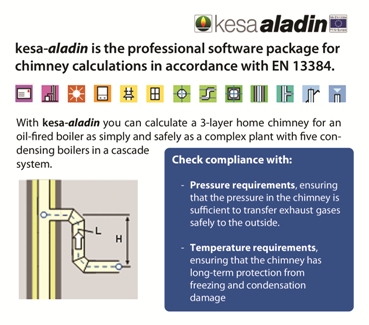Calculating chimneys in accordance with BS EN13384 Standards.
This page provides an outline of the chimney and flue calculation process. The UK Government's latest guidance for Building Regulations for combustion appliances references the approved calculation procedure of BS EN13384 as an alternative method. This is a complex calculation with multiple variables, which can be simplified using professional software. This page explains how chimneys can be optimally designed to provide sufficient draught, minimise air pollution and ensure compliance with temperature and pressure regulations.
In October 2010 a guide to the latest England & Wales Building Regulations for combustion appliances less than 50kW was released in the form of Approved Document J. This contained guidance on methods for calculating chimneys and flues, referencing the approved calculation procedure within BS EN13384. The guide gives this method as a suitable basis 'for deciding whether a chimney design will provide sufficient draught' (ADJ pg. 30). This standard allows an alternative from the usual rules-of-thumb providing that a calculation is undertaken.
The standard contains a number of complex calculations with multiple variables. This is not surprising as chimney draught varies due to a wide range of factors. Temperature is one of these factors, and so it must be considered whether the chimney is located inside or outside the building as well as chimney insulation levels. The speed of flue gases, diameter, height and number of bends all play their part.

Producing successful calculations necessitates juggling complex hydraulic equations. These are all interconnected, as when one variable (such as neighbouring building heights or humidity) changes then all others are also affected. This is an iterative process which is very difficult to optimise manually, and such calculations are normally done using dedicated computer software such as kesa-aladin.
For smaller sub-50kW systems it is often sufficient to follow the guide rules-of-thumb, but for systems producing over 50kW or with multiple appliances, a calculation becomes the preferred choice for accuracy.
Professional computer software such as kesa-aladin enables installers and engineering consultants to run different chimney possibilities and prove that a chimney system will meet with BS EN13384.
Good, clean combustion requires a good chimney. To achieve improved air pollution and meet the Government's Cleaner Air agenda, chimney design needs to be optimised. Using the EN13384 standard offers improved defence against negligence claims. Using software like kesa-aladin to calculate to this standard is a time and risk saver in the long run. Installers and engineering consultants increasingly prefer the freedom to make their own calculations between different chimney brands, with the convenience of manufacturers' details available in a digital database alongside the calculation.
kesa-aladin chimney calculation software transforms the initially onerous EN13384 calculations into a more visual method and allows customers to appreciate the process in more detail.